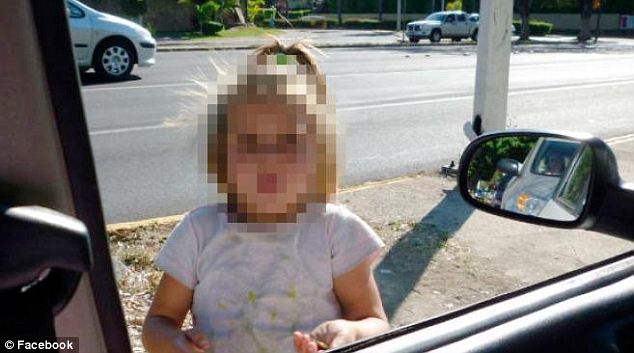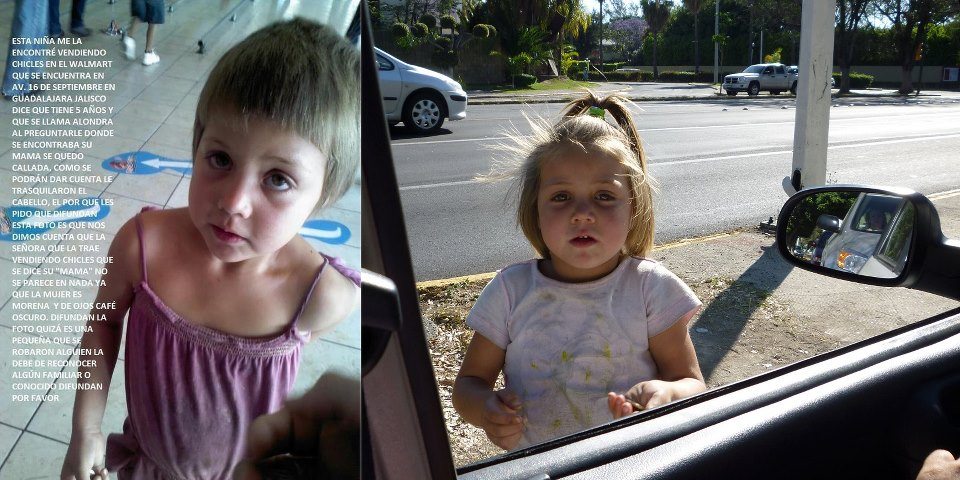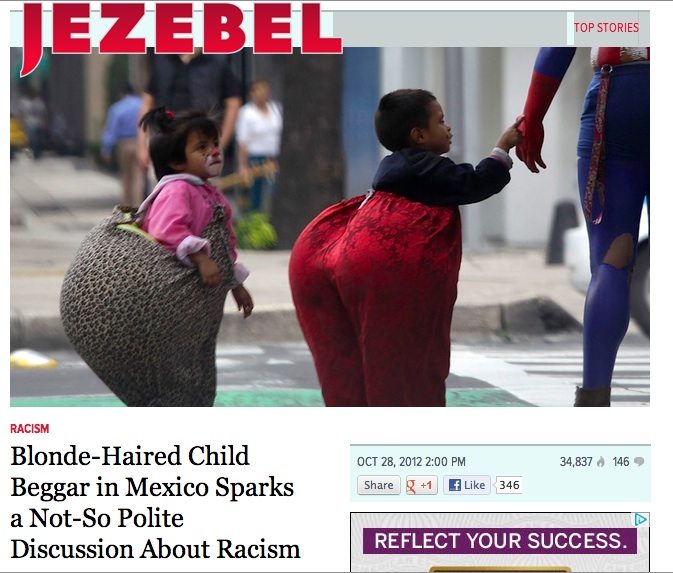UPDATED, October 29, 9:25PM EST: A reader shared the original Facebook pic that shows two pictures of the child and how the person who took the pictures questioned that she might have been kidnapped because the "mother" was darker than the little girl.
The last few days a story from Mexico made the English-language online media in both the U.S. (CBS News, Jezebel) and the U.K. (The Daily Mail). The story involved a person in a car uploading a Facebook photo of a 5-year-old blonde and green-eyed girl begging on a Guadalajara street after believing that she was kidnapped because, hey, she was blonde and had green eyes, and she didn't look like the darker "mother" who was with her.
The photo, because it was the photo of a blonde child street beggar with green eyes, was shared more than 68,000 times on Facebook. Many believed that the girl was indeed kidnapped, because as you might guess, why would a blonde girl street beggar with green eyes be begging in Mexico?
Race and Mexico's legacy as a country that to this day treats racism as a badly-kept secret hiding behind affectionate terms (negro, chino, güera, indio, etc. etc.), became a huge part of the story. So huge that the local police and authorities in Guadalajara acted on the suspicion from social media that the little blonde and green-eyed girl was indeed kidnapped. She wasn't. She had parents, and the little girl, known locally as "la Güerita de la Canaco," is just like a lot of other poor kids in Mexico who have to beg on the streets. In the end, the little girl was taken to an orphanage, and the story continues.
Now, the police deny that racism was not the motive for checking to see if the little girl was a victim of a kidnapping. Yeah, right.
Let's admit it: if there is one ugly stain about Mexico (as well as all of Latin America), it is a culture of institutionalized racism and classism. Wait, a blonde girl with green eyes was begging on the street? Something must be done! In the end, this story confirms that Mexicans should be waking up and asking themselves, "why do so many kids beg in the street?", instead of posting their outrage at the thought of a little blonde girl with green eyes being forced to beg on the street. How elitist and racist can people be? A lot. Here's hoping that changes.
Which brings us to the current English-language coverage of this story. First up, CBS News, which ran a wire piece from the Associated Press: "Case of Blond Girl Beggar Strikes Nerve in Mexico." The AP story includes the following:
The attention to the Facebook photo and the way officials rushed to find her and detain her mother have renewed a debate about racism in Mexico, where millions of indigenous people live in poverty and passers-by often barely notice the dark-skinned children begging in the street.
What the AP story fails to even mention or even begin to discuss are the reasons WHY extremely poor kids in Mexico have to beg. Instead, the brief story suggests that there is racial outrage in Mexico, without really going into any depth about the social, historical, and economic causes behind racism in the country, and also why the country and its leaders continue to ignore countless of Mexican children who are subjected to such a tragedy. Nice glossing over of the story, AP. You really have no clue.
Next, let's turn to Jezebel. The Jezebel story basically regurgitated the AP story from the CBS News site. But, and this is a big but, it ran the picture of two unidentified Mexican kids in costumes without a caption and over the story's headline. Does Jezebel think that such an image added any value to the story? Here is the screen capture:
One Jezebel commentator said it best, so we are just going to share that comment here:
This is a photo of two children in costume for a festival, not an example of children who beg or sell gum in the streets all around Mexico. [EDITORS NOTE: actually, they are beggars, but that is not the point of this comment, continue reading] I appreciate that you covered this story, but your choice of photo seems offensive and unrelated to the article. Your photo suggests that the two brown children pictured – with what appears to be a supervising adult to the right – are beggars when nothing in the photo suggests this, and thus supports a racist line of thinking that your article purports to be addressing. It is tragic that people would be offended by authorities trying to help any child, but it highlights the gross reality that children in Mexico work in dangerous and compromising ways to, often to support their very poor families, the majority of who are indigenous and many of whom do not speak Spanish as a first language and are disenfranchised by their poor educational system. The best we can hope for at this juncture is that the sensationalism of this event does bring more attention to the devastating issue of child workers in Mexico, and it's connection to the greater issues of systemic racism and poverty in the same country where the richest man in the world, Carlos Slim, lives.
BOOM. Truth. Actual insight from what Jezebel wrote.
Which leads us to The Daily Mail. Now, the story actually adds a bit more, much more than the AP and Jezebel. For example, here is an excerpt:
The case sparked international outrage.
"We need to see a white girl to worry about kidnapping, trafficking of children and child exploitation," wrote human rights activist Yali Noriega. "I've never seen photos of Indian children or simply dark-skinned kids circulating on the Internet with people asking others to help them."
Others believe the mother could sue the government for taking her daughter based only on uninformed public opinion.
"It is not right that just because of the color of her skin, they can say it's not her daughter," said Xochitl Galvez, a former federal Cabinet minister who is an advocate for Indian rights. "There is no such thing as a pure race. We are a mix … that tells you a lot about the authorities' lack of knowledge."
But the Daily Mail fails as well, and here is why. The story posted the Facebook image of the girl with her face blurred, but then proceeded to post two pictures of poor brown-skinned children begging in the streets. What are you trying to suggest, Daily Mail? Don't answer that. We suspect what your motive was.







Why do you think even those of us who are foreign residents Mexico stopped believing the U.S.-British news coverage of this country long ago?
True @Mexfiles it is awful. An opportunity for the world to start actually discussing real issues but nada.
My family is from the Guadalajara area. They were, at times, very, very poor. And, most of them (not all, but most) are very fair skinned with green/blue eyes and light colored hair. I don’t want to minimize the racism in Mexico (or the rest of Latin America, for that matter), it is real and severe. I have felt the sting of it myself because I am more mestiza looking than the average person from Guadalajara (or in my family). But, the non-Mexican idea that light-skinned people in Mexico are *never* poor, that they all live in Mexico City (and star in soap operas) and that this child is some sort of anomaly is the fallacy that underlies this whole story. Poverty in Mexico is widespread, and while the country does stratify along skin color and race in a very disturbing fashion, poverty also crosses skin color barriers in familiar way to those of us from the United States (witness the American South and many places in rural America). Places like Jalisco, Zacatecas, Guanajuato have a lot of light-skinned people in them and some of them are poor, very poor. Get over it. Yes, I’m sure that more indigenous people in Southern Mexico suffer from more and perhaps more severe poverty, that is true, probably. But, talking intelligently about race, racism, classism and their attendant prejudices means that we should acknowledge the anomalies and the complications that are also part of this story — that is what i hate about the coverage of this story. Everybody wants to underscore the dark skin equal poor and light skin equal rich theme that underscores this story. It is not that simple, people. It never was.
@Cristi101 — THANK YOU, ¡MIL GRACíAS! I’ve had a hard time getting this across even to other “assimilated immigrants” and naturalized Mexicans from the north … and even some Mexican-Americans… who seem to view Mexico’s complicated class/ethnicity issues through the lens of telenovelas. Interesting sideline is that people from Los Altos (Jalisco, Guanajuato, Zacatecas) were noted for being light-skinned even before the Conquest (and a lot of nonsense was written in the 19th century trying to “prove” the “Indians” were Vikings or English, or anything other than native Americans). And, of course, Mexico (and Latin America) did do a better job of overcoming racism in a simple way. They made love, not war 🙂
But let’s not pretend @Mexfiles that institutionalized racism and classism does not exist in Latin America and Mexico. It is engrained in the culture.
@Cristi101 I am Anglo but I have lived with/among Mexicans for a good portion of my adult life. As such, I grew to understand many of the differences and subtleties of Mexican people from their different regions. In fact, I used to sort of show off when I met somebody by guessing/asking them what part of Mexico they are from often in a colloquial way (Eres chilango? Eres Tapatio, Eres jarocho? etc.) I was pretty good at doing this but I invested a significant amount of my life and time into learning. I’ve had conversations with people that have explained to me the history of the Spanish in Guadalajara. I am also familiar with the unique “ojos Tapatios” that distinguish people from the Jalisco region. While I might know a lot about Mexico, there are a lot of cultures and people I don’t know a lot about and could be prone to make similar mistakes as the media did here. But, ultimately, I do think this is more than racist (even though race has something to do with). I really think this is also nationalist and pertains to the mistrust of Mexico and Mexican people that has been created in the press over the years. To level a charge of kidnapping is really the part of the created perception that Mexico is corrupt throughout and there are many politically and economically that stand to benefit from this perception.
Thanks for sharing @DignityPeace
That is the point @Cristi101 and everyone has missed it, so thanks for sharing! We should be asking the bigger question: kids begging on the street and why it continues in Mexico.
[…] By Latino Rebels […]
plenty of poor white kids in Southern Brazil. Here, an image of kids in a favela in Porto Alegre (overlooking the recently reformed for the WOrld Cup Beira Rio stadium)
http://www.info-stades.fr/forum/ressources/image/51243